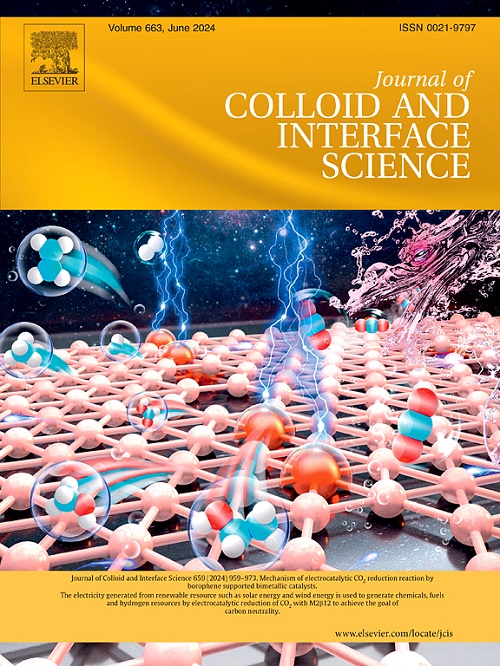天然超氧化物歧化酶激发的异质结构N, s共掺杂CoFe₂O₄/MoC电催化剂的高效水分解
IF 9.7
1区 化学
Q1 CHEMISTRY, PHYSICAL
引用次数: 0
摘要
目前关于异质结作为析氧反应(OER)和析氢反应(HER)催化剂的研究主要侧重于异质结界面上的电子转移过程。然而,掺杂元素在异质结构中的调节作用仍然没有得到充分的探索,尽管它对高效催化剂的进步具有重要的科学意义。受自然界观察到的超氧化物歧化酶(SOD)催化超氧化物歧化酶反应的启发,本研究提出了一种新型异质结构N和S共掺杂CoFe2O4/MoC电催化剂。N和S的加入在CoFe₂O₄/MoC异质结构体系中引起了独特的“电子拖动”效应,选择性地调节了HER和OER过程中电子的接收和释放,从而确保了各种活性位点的最佳电子密度。设计的N, S-CoFe₂O₄/MoC-NS电催化剂在低至1.47 V的电位下实现了100 mA cm−2的总水解电流密度,并在300 h内保持稳定输出而不降解。理论计算和原位拉曼光谱表明,异质结构的形成和“电子拖拽”效应对调节不同的活性位点至关重要,为催化剂活性和稳定性之间的平衡提供了新的见解。本文章由计算机程序翻译,如有差异,请以英文原文为准。

Natural superoxide dismutase inspired Heterostructural N, S-Codoped CoFe₂O₄/MoC Electrocatalyst for highly efficient water splitting
Current research on heterojunctions as catalysts for the oxygen evolution reaction (OER) and hydrogen evolution reaction (HER) primarily emphasizes the electron transfer processes at the heterojunction interface. However, the regulatory role of doped elements within heterostructures remains inadequately explored, despite its significant scientific implications for the advancement of efficient catalysts. Inspired by the catalytic superoxide dismutation reaction of superoxide dismutase (SOD) observed in nature, this study presents a novel heterostructural N and S co-doped CoFe2O4/MoC electrocatalyst. The incorporation of N and S induces a distinctive ‘electron-dragging’ effect within the CoFe₂O₄/MoC heterostructural system, selectively modulating the reception and release of electrons during HER and OER processes, thereby ensuring an optimal electron density at various active sites. The designed N, S-CoFe₂O₄/MoC-NS electrocatalyst achieves a total hydrolysis current density of 100 mA cm−2 at a potential as low as 1.47 V and maintains stable output for 300 h without degradation. Theoretical calculations and in-situ Raman spectroscopy suggest that the formation of the heterostructure and the ‘electron-dragging ‘effect are crucial in regulating different active sites, providing new insights into the balance between catalyst activity and stability.
求助全文
通过发布文献求助,成功后即可免费获取论文全文。
去求助
来源期刊
CiteScore
16.10
自引率
7.10%
发文量
2568
审稿时长
2 months
期刊介绍:
The Journal of Colloid and Interface Science publishes original research findings on the fundamental principles of colloid and interface science, as well as innovative applications in various fields. The criteria for publication include impact, quality, novelty, and originality.
Emphasis:
The journal emphasizes fundamental scientific innovation within the following categories:
A.Colloidal Materials and Nanomaterials
B.Soft Colloidal and Self-Assembly Systems
C.Adsorption, Catalysis, and Electrochemistry
D.Interfacial Processes, Capillarity, and Wetting
E.Biomaterials and Nanomedicine
F.Energy Conversion and Storage, and Environmental Technologies

 求助内容:
求助内容: 应助结果提醒方式:
应助结果提醒方式:


